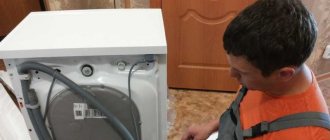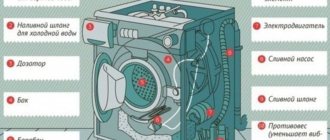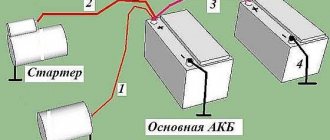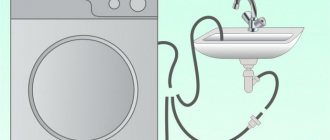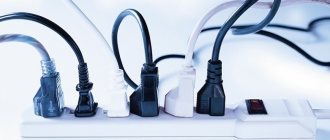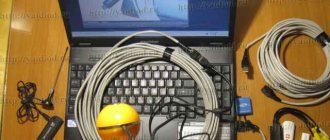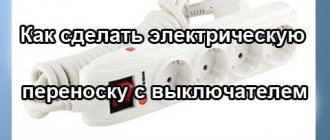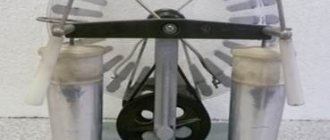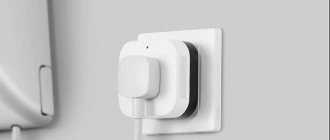Extension cord for automatic washing machine
It happens that people suddenly need to protect themselves and their automatic washing machine from short circuits and electric shocks. At the same time, of course, no one wants to redo electrical communications. I want to stay with the old socket and battered two-core aluminum wiring without ground, while somehow protecting myself. And so, the market responded to the wishes of customers by launching an extension cord with an RCD for automatic washing machines. Can such an extension cord really protect someone? Read the article on how to choose such an extension cord with an RCD.
How useful is such a device?
First, let's figure out how useful an extension cord with an RCD is for a person in general and for a washing machine in particular. An extension cord with an RCD is essentially an ordinary extension cord, the body of which has a built-in protective power switch. In the event of an overload in the electrical circuit caused by various reasons, the RCD urgently opens the circuit, de-energizing it.
In principle, it’s not bad if you use such a device somewhere on a construction site or during repairs to connect a hammer drill, grinder and other power tools. But we need to figure out the question: can such an extension cord be used to connect a washing machine? As a general rule, you can't. The fact is that a washing machine is a large consumer of electricity, which must be connected to a separate moisture-resistant socket protected by an RCD, and also so that the cable supplying the socket has a suitable cross-section.
The problem is that the washing machine does not produce a peak of power immediately, but at the end of the program during the spin cycle. At the same time, trouble can occur with the wrong socket and wiring.
How to choose an extension cord: characteristics
Electrical extension cords are produced by industry in various versions: with one socket in a block or several, as well as a switch, voltage indicator, residual current devices (RCDs) or without them.
Since the washing machine operates in conditions of high humidity, there is a possibility of water getting on live parts. This determines increased requirements for the electrical safety of the extension cord in contact with equipment.
Features to look for when choosing an extension cord for your washing machine:
- Cross section, length of wire, material from which it is made.
The thickness of the core is calculated based on the power of the washing machine: for example, for a load of 2.5 kW, the current strength at a voltage of 220 V will be 2500/220 = 11.4 A. This means that the cable will be required taking into account starting surges of 16 A, which corresponds to the cross-section of the copper wire 1.5 mm². Please note that aluminum is not used in the manufacture of extension cords.
In this case, the optimal length of the device should not be less than 3–7 m.
- Socket block, equipped with grounding.
Large household appliances already place a heavy load on the extension cord, so the number of sockets in the extension cord should be minimal - 1 connector is enough. The presence of a grounding wire in this case is mandatory. It is distinguished by its double yellow-green color.
- Plug for connection to a fixed socket.
Most often, in extension cords there are non-separable models of plugs with two power pins and two grounding brackets. The device protection class must be IP20 - against moisture and dust, IP44 - against splashes.
- Electrical short circuit protection device.
The circuit breaker is a device built into the carrier that can absorb electrical surges. It is equipped with one main fuse - a fuse, and two additional ones: fast-acting and thermal.
When choosing an extension cord for a washing machine, preference should be given to well-known domestic and foreign manufacturers.
It should be borne in mind that the price for a product with grounding is twice as high as for a similar device without it.
Is it possible to turn on a washing machine through an extension cord - Construction, repair, arrangement
Scientists note that compared to the last century, the activity of society has increased significantly, and therefore almost all of us have begun to feel a total lack of time to solve everyday issues.
In order to reduce the burden on a person and provide him with a comfortable everyday life, special devices were created that, in a relatively short period of time, have already been able to win the hearts of many consumers and continue to be in demand to this day.
As a rule, household equipment that we use constantly, for example, air conditioners, boilers, multicookers and microwaves, run on electricity. The washing machine occupies a leading position among acquisitions due to the presence of certain advantages:
- minimizing human labor;
- a large selection of actions to be performed, the presence of many programs;
- beautiful external component.
However, in order to use the equipment, you need to know how to connect the washing machine to the water supply and sewer systems, and position the product so that during operation it does not wobble or “jump” around the room.
Whether you turn to specialists for help or carry out the installation of the device yourself is up to you. However, we note that independently carried out manipulations for installing a washing machine will be a good help for further study of the installation features of other types of household appliances.
Deciding on the location
Let's say you have already selected a suitable model of washing machine in the store that suits you in terms of quality, cost and set of built-in programs. It's time to think about where to install the unit, because changing the location of the product will no longer be possible.
Traditionally, washing machines are installed in bathrooms; this is the most convenient option, because the necessary pipes for connection pass through here, and the drain is also located. However, if the bathroom is limited in space, the device is by default moved to the kitchen or hallway. A small cabinet designed to match the overall design of the room will help hide equipment from prying eyes.
Can I install a washing machine in the bathroom?
The bathroom is not an ideal place for a washing machine. However, if size allows, it is fine for the washing machine to be installed in the bathroom - as long as electrical safety regulations are followed. For example, it is necessary that the washing machine in the bathroom is grounded so that it cannot be accidentally touched during the wash cycle.
That is, it is highly advisable to place the washing machine in a separate niche or dead end, and not on the aisle.
Why can't you connect your washing machine through an extension cord?
Faced with the problem of connecting a washing machine in a new apartment, I learned interesting information about carriers, wiring features and RCD (residual current device). Many of us don’t think about it, but the instructions for washing units state: “cannot be plugged into extension cords.” Why is that?
Safety precautions
In modern new buildings, developers are starting to make normal moisture-resistant sockets in the bathroom, facilitating further work on installing washing machines. But in most houses, the sockets are located somewhere in the corridor or room, and the cord of the machine is short, on average a meter and a half, no more. What to do? Resourceful people simply go to any hardware or electrical store and buy the first extension cord they like. It turns out that doing this is strictly prohibited! That's why:
- Often the carriers lie on the threshold, next to a working appliance or in the corridor. Such a neglectful attitude leads to unpleasant consequences: you can touch them with wet hands or bare feet and end up getting an electric shock.
- The cord under the door begins to fray and bend, losing its elastic and protective properties. Consequence? That's right, electric shock.
- Out of habit, we plug other devices into the extension cord, overloading the network. The carrier starts to heat up, and an automatic shutdown may work, which is also not good for the equipment! An emergency shutdown can cause the program to crash, and we will need a wizard.
- The constant use of different plugs, which do not always match the diameter of the pins, leads to wear and tear, and a washing machine is a powerful piece of equipment; it needs ideal operating conditions and constant current.
Our heart works from electrical impulses, which is why it is so afraid of electric shock. Even slight tension causes a malfunction of the heart muscles! Sometimes it’s better to be safe than to put your life and health at risk!
Technical requirements for direct current, grounding and power lead us to the fact that we still need a separate channel with special protection from moisture.
What does connection actually look like in modern realities?
Considering the complexity of work in the bathroom, our people have come up with several ways to circumvent the ban.
- Buy a personal extension cord for only one device. In fact, another socket is also a kind of carrier, but laid in the wall according to all the rules of science.
- Carrying must be of high quality and grounded! Some people make their own, while others buy them in a store. For example, it has proven itself well. Its carriers are equipped with protection; in the event of a power outage or overheating, the device will turn off and prevent expensive equipment from burning out.
- Extend the cord to the required length . But here pitfalls emerge in the form of constant exposure of the door to the wire. It will gradually wear out and there will be a risk of short circuit, electric shock or fire.
The best way is to conduct grounded wiring from the panel directly to the bathroom and not worry!
In case of emergency
The washing machine needs a separate outlet, but while specialists are installing it, you can use an extension cord as a temporary option. But the connection via an adapter must be organized according to all the rules. You can’t buy the first one you come across or take an old home one - you need a high-quality carrier with a sufficient cross-section. It is important to ensure that it has several important characteristics.
- Wire section. The machine puts a decent load on the network, which a conductor with a core diameter of at least 2.5 can withstand.
- Separate use. The washing machine requires a personal extension cord.
- Sufficient length. Immediately calculate the distance to the outlet and purchase a proportional adapter. It is not permissible to use multiple extension cords.
- Quality. The Pilot brand has proven itself to be excellent, offering high-quality electrical products that meet all standards.
- Security. It is important that the carriers are protected from moisture and overvoltage. The presence of grounding will prevent the equipment from burning out due to power surges and current leakage.
It is worth understanding that connecting through an extension cord, even a high-quality and protected one, is a big risk. It is better not to delay or experiment, but to establish a full-fledged connection to the power grid with a separate RCD.
Which device should I buy?
The range of products is quite wide, but washing machines require certain models. As already mentioned, the extension cord must be equipped with an RCD. You can choose from the following products:
- German electrical extension cord Brennenstuhl. This is a high-quality model with a sensitive RCD, copper conductors, a plug protected from moisture and dust, an indicator and a switch. The main disadvantage of the device is its high cost. The minimum cord length is 5 meters;
- electrical extension cord UB-17-u, manufactured by the Russian company. This is a 16 Ampere model with a wire cross section of 1.5 mm². The residual current device operates instantly. A significant drawback can be the length of the cord - at least 10 meters;
- extension cord UB-19-u. Product from the same manufacturer. The characteristics are as follows: 16 Amperes, cross-section 2.5 mm². Equipped with an RCD and a waterproof plug.

